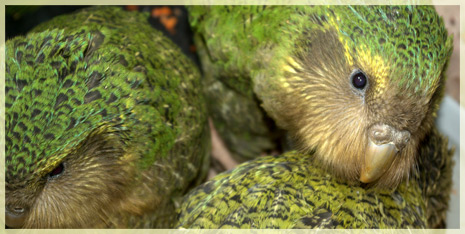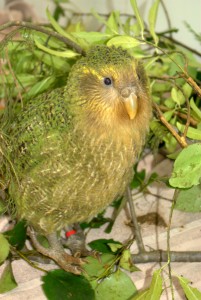
“Step right up, it’s only one dollar. Step right up and gaze upon this incredible creation of nature that boasts a critically endangered status, has the honor of being the world’s heaviest parrot, roams the night for food, can live up to 90 years of age, and dare say is flightless.”
Just describing the kakapo makes it sound as though it is a feature at an early 20th century circus sideshow that by all means would draw a crowd…of birders and conservationists alike. In a continuing recovery saga, conservationists in New Zealand have been diligently working to save this remarkable species from extinction. And in the latest chapter,
New Zealand’s kakapo recovery team has successfully returned the last four kakapo chicks to their birthplace on Whenua Hou / Codfish Island this morning (July 10, 2009), marking a significant milestone for the 2009 breeding season.
The four baby kakapo were among 26 chicks removed from the island in April and hand-reared in a special facility in Invercargill after a shortage of their staple diet – ripened rimu fruit – threatened the chicks’ survival.
Now 90 days old, the chicks will spend up to six weeks in temporary outdoor pens while they acclimatise to the island conditions and are weaned off the hand-rearing diet.
At the end of their acclimatisation, each kākāpō will be fitted with a tracking transmitter and slowly introduced into the wild in small groups around the island.
Not unlike other endangered species, the kakapo suffered as a result of human colonization and the introduction of invasive species that chipped away at a home range that once extended throughout New Zealand. As populations continued to dwindle in the mid 1970s, 18 birds in Fiordland and approximately 150 on Stewart Island, a concerted effort to save the species needed to be organized. According to the IUCN Red List, the Stewart Island population was at the mercy of feral cats who were responsible for killing over 50% of monitored kakapos each year.
Thus, over a 12 year period beginning in 1980, the 61 remaining birds were relocated to a predator-free offshore island. With the discovery of a lone female on Stewart Island in 1997, the entire population was comprised of a mere 62 individuals by 1999. As management and breeding programs began to show signs of success, the population grew to 86 birds in 2005, and  presently stands, including this year’s surviving chicks, at 124 birds, which is twice the population 10 years ago.
presently stands, including this year’s surviving chicks, at 124 birds, which is twice the population 10 years ago.
The kakapo joins the ranks of a few avian species, such as the California condor, the Black Robin and Hawaiian goose, that have benefited from direct intervention and reduced the immediate or imminent threat of extinction.
Kakapo facts:
• The kakapo is the world’s heaviest parrot – males can weigh over 2kg.
• Unique among land birds, kakapo can store large amounts of energy as body fat.
• It is the only parrot to have a ‘lek’ mating system: in summer, kakapo males compete for ‘calling posts’ in dug-outs, from where they ‘boom’ (call) each night for a female.
• The kakapo’s low-frequency mating boom travels several kilometres.
• It is the only parrot to have an inflatable thoracic air sac.
• kakapo breed every three to four years.
• A bird can range several kilometres in one night.
• kakapo are flightless but good at climbing trees.
• kakapo are herbivores that feed on roots, leaves and fruit.
• kakapo once ranged from near sea level to high in the mountains.
• Possibly as defence against an ancient predator – the giant eagle – kākāpō became nocturnal and learned to ‘freeze’ (remain still) when in danger.
Facts Credit: the New Zealand Tourism Board (http://www.newzealand.com)
Photo Credits: Sam O’Leary of New Zealand Department of Conservation

[…] The critically endangered, world’s heaviest, flightless parrot … […]
Very interesting Scott. Do you know if there is now any legal way of “twitching” it. That is , I understood it was off limits for ordinary birders. Is that still the case?
Thanks Gunnar. I believe you are correct and as according to the Kakapo Recovery Programme, Codfish Island is “a specially-protected nature reserve, and no unauthorized landing is permitted.”
Wonderful news! I fell in love with the Kakapo when I saw David Attenborough’s Life of Birds. I am so gald their recovery is progressing. Maybe some day before I die, ordinary birders will be able to go and see them. I really, really hope so. Thanks for the report!